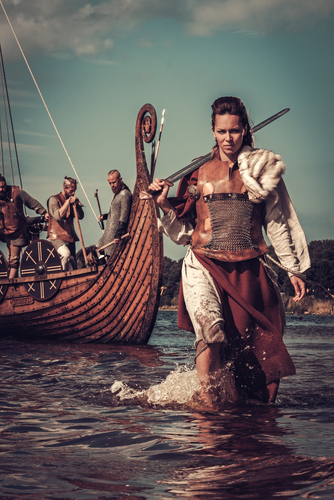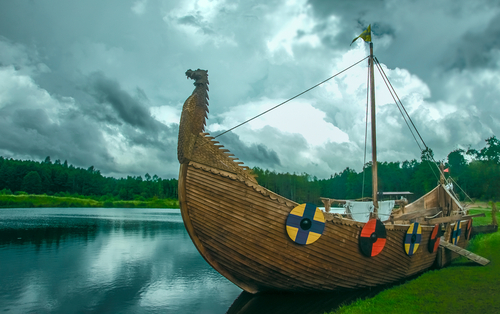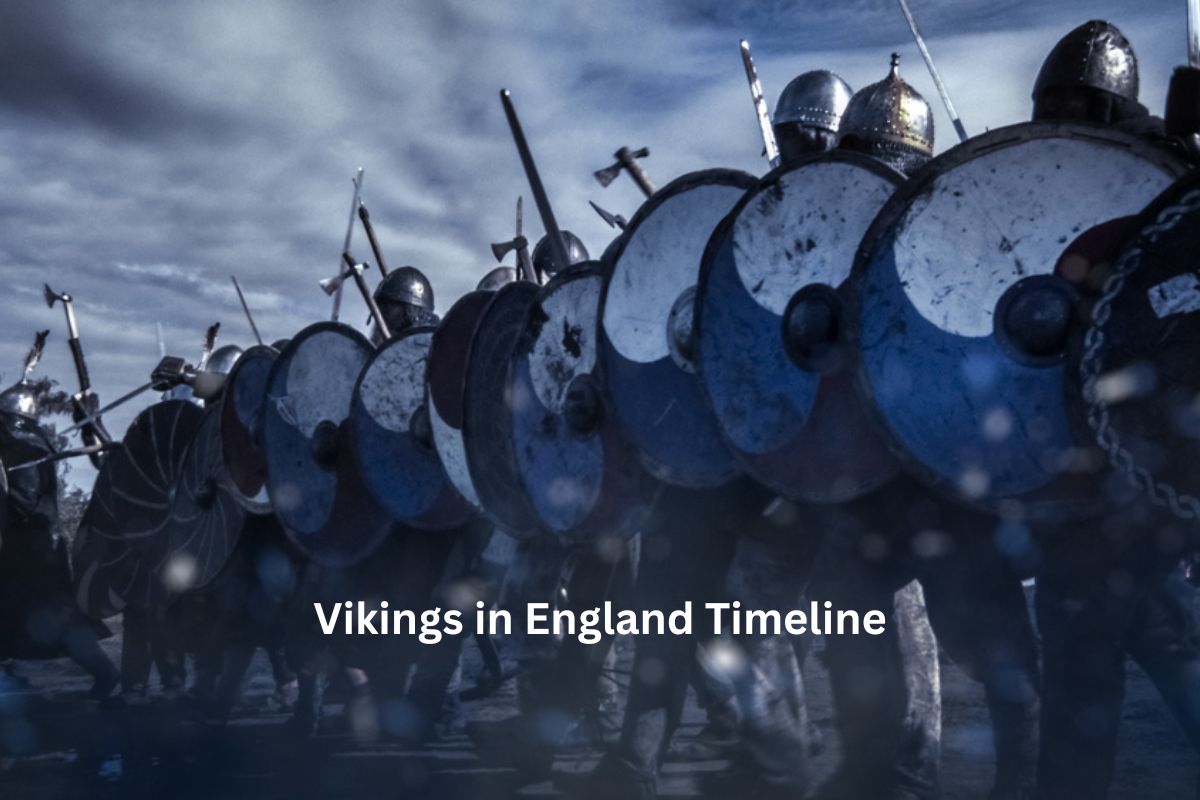The Viking presence in England, spanning from the late 8th to the 11th century, was a pivotal and transformative period in English history.
Hailing from the Scandinavian lands of Norway, Sweden, and Denmark, the Vikings embarked on a series of raids, conquests, and settlements along England’s coasts and inland regions.
These Viking incursions reshaped political boundaries, cultural dynamics, and societal structures in what would later become the United Kingdom.
From the early raids to the establishment of Viking kingdoms, coexistence with the Anglo-Saxons, and eventual Norman Conquest, the Vikings left an indelible mark on England, influencing its language, culture, and heritage for generations to come.
| Time Period | Key Events and Viking Activities in England |
|---|---|
| Late 8th Century | Viking raids on the coast of England begin. |
| 793 | Lindisfarne Raid marks the start of Viking raids in England. |
| Late 8th – 9th C. | Ongoing Viking raids targeting Northumbria, East Anglia, and Mercia. |
| 865-878 | The Great Heathen Army invades England, capturing York and Jorvik. |
| 878 | Alfred the Great defends Wessex and establishes the Danelaw. |
| 10th Century | Vikings settle in England, coexisting with the Anglo-Saxon population. |
| 1013-1014 | Sweyn Forkbeard briefly conquers England. |
| 1016 | Cnut the Great establishes a North Sea Empire, including England. |
| 1042 | Edward the Confessor ascends to the throne, ending Danish rule. |
| 1066 | Norman Conquest led by William the Conqueror ends Viking influence. |
| 1086 | The Domesday Book is commissioned by William the Conqueror. |
Timeline of the Vikings in England
Late 8th Century – Viking Raids Begin
In the late 8th century, the Vikings, who were seafaring people from Scandinavia (modern-day Norway, Sweden, and Denmark), began launching raids on the coast of England.
Also Read: Viking Longship Facts
These early raids primarily targeted vulnerable coastal areas, including monasteries and isolated settlements. The primary motive for these raids was often plunder, as the Vikings sought valuable items, including gold, silver, and religious artifacts.

793 – Lindisfarne Raid
The Lindisfarne Raid, which occurred in 793, is often regarded as the starting point of Viking raids in England. Lindisfarne was an important Northumbrian monastery located on Lindisfarne Island (Holy Island) off the northeast coast of England.
Also Read: Viking Women Facts
Viking raiders, who were likely from Norway, attacked Lindisfarne, looting the monastery and terrorizing the monks. This event shocked the Christian world and marked the beginning of a period of sustained Viking attacks on English shores.
Late 8th – 9th Centuries – Ongoing Viking Raids
Following the Lindisfarne Raid, Viking raids continued to escalate in frequency and intensity throughout the late 8th and into the 9th century.
The Vikings targeted various regions of England, including Northumbria, East Anglia, and Mercia, as well as other parts of the British Isles and Europe. These raids often resulted in widespread destruction and disruption of local communities.
Viking longships, designed for speed and shallow waters, allowed the raiders to navigate rivers and penetrate deep inland, making them a formidable threat to inland regions.
865-878 – The Great Heathen Army and the Establishment of Jorvik
In 865, a massive Viking force known as the Great Heathen Army, composed of warriors from various Viking tribes, arrived in England. This army was intent on more than just raiding; they aimed to conquer and establish a permanent presence.
The Great Heathen Army quickly captured the city of York in 866 and established a Viking kingdom known as Jorvik. This kingdom covered a significant portion of what is now northern England.
Under the leadership of kings like Ivar the Boneless and Guthrum, the Vikings consolidated their rule in Jorvik and extracted tribute from the surrounding Anglo-Saxon kingdoms.

878 – Treaty of Wedmore and the Danelaw
In 878, King Alfred the Great of Wessex, one of the Anglo-Saxon kingdoms, successfully defended his kingdom against the Viking onslaught. The two sides eventually agreed to a peace treaty known as the Treaty of Wedmore.
The treaty had several key provisions, one of which established the Danelaw. The Danelaw was a division of England where Viking law and customs prevailed. It included parts of Mercia, East Anglia, and Northumbria.
This division acknowledged Viking control over these regions while allowing Anglo-Saxon rule to persist in Wessex and other southern areas.
10th Century – Viking Settlements and Coexistence
Throughout the 10th century, Vikings continued to live and settle in various parts of England, especially in the Danelaw. This period saw the coexistence of Viking settlers and the native Anglo-Saxon population.
Viking settlers often assimilated into the local culture and adopted Christianity, leading to a blending of Viking and Anglo-Saxon traditions and practices.
The Danelaw became an important center of trade and urbanization, with towns like York (Jorvik) growing in size and importance. This era also witnessed the establishment of strong trade connections between England and the Viking homelands in Scandinavia.
1013-1014 – Sweyn Forkbeard and the Conquest of England
In 1013, Sweyn Forkbeard, a Danish king, launched a successful invasion of England. Sweyn’s forces quickly overran the Anglo-Saxon kingdoms, and he declared himself King of England.
Sweyn’s rule, however, was relatively short-lived. He died in 1014, and the Anglo-Saxon king Æthelred the Unready briefly regained control of England.

1016 – Cnut the Great and the North Sea Empire
In 1016, Cnut the Great, another Danish king, continued the Danish conquest of England. After a series of battles and negotiations, he defeated Edmund Ironside, the son of Æthelred the Unready, and became the undisputed King of England.
Cnut’s reign marked the establishment of a North Sea Empire that included England, Denmark, Norway, and parts of Sweden. He ruled England until his death in 1035.
1042 – Edward the Confessor and the End of Danish Rule
Edward the Confessor, an Anglo-Saxon king, ascended to the English throne in 1042 after Cnut’s death. This marked the end of direct Danish rule in England.
Edward’s reign brought relative stability and the reintroduction of Anglo-Saxon traditions. He is also known for his construction of Westminster Abbey.
1066 – Norman Conquest and the End of the Viking Age
In 1066, the Norman Conquest led by William the Conqueror, a descendant of Viking settlers in Normandy (Northern France), brought an end to the Viking Age in England.
The Battle of Hastings in 1066 resulted in the defeat of King Harold II of England and the establishment of Norman rule.
While not Vikings themselves, the Normans were of Viking ancestry, and their conquest had a profound and lasting impact on England, including the introduction of Norman-French culture and language.
1086 – Domesday Book and Post-Viking England
In 1086, William the Conqueror commissioned the Domesday Book, a comprehensive survey of England’s land and property ownership. This detailed record provided valuable insights into the state of England in the years following the Norman Conquest.
The Domesday Book is a crucial historical document for understanding the social, economic, and political changes that occurred as England transitioned from Viking and Anglo-Saxon rule to Norman rule.
